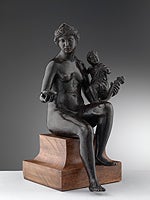Andrea Riccio: Renaissance Master of Bronze
October 15, 2008 through January 18, 2009
Exhibition Checklist
 |
|
Boy with a Goose
c. 1515–20
Bronze
Kunsthistorisches Museum, Vienna, Kunstkammer
Cat. No. 32 |
Riccio based this bronze masterpiece on a fragmentary large-scale
ancient marble statue that was missing the boy’s head
and the goose’s beak. The boy’s impish jubilation and the
squawking bird’s terror are Riccio’s inventions. Wrestling,
in noisy and violent embrace, the figures rotate in space,
inviting examination from all sides. The bronze is exquisitely
tooled. Riccio achieves childhood’s supple plumpness by
lightly hammering the bronze surface. The chiseling of each
feather evokes the downy slickness that makes birds difficult
to hold. This high level of tooling is rare in Riccio’s work.
Its effects appear only in the smooth body and minutely
articulated coiffure of Riccio's “Abundance”.
 |
|
Pagan Boy (Sacrificial Servant?)
c. 1515–20
Bronze
Kunsthistorisches Museum, Vienna, Kunstkammer
Cat. No. 31 |
The boy’s classical tunic, small vessel, and decorative garlands
identify him as a participant in a ritual pagan sacrifice.
Although the figure is just big enough to be an independent
statuette, its small size suggests that the Pagan Boy may
have belonged to a larger ensemble. As he strides along, the
child looks up momentarily, as if at another figure or even
the viewer. The crisp costume folds, bold tresses of hair, and
weighty foliate garlands are modeled and sketched in the
wax with swift, compelling naturalism. The boy’s lively
expression and costume form a basis for the attribution of
the “Abundance” to Riccio.
 |
|
“Abundance”
c. 1520 (?)
Bronze
Museo Nazionale del Bargello, Florence
Cat. No. 33 |
The crowned, seated female nude holds a shell in her
right hand. On her left arm she bears a small child and
a cornucopia. This attribute-laden figure evokes ancient
Roman bronze statuettes of household gods, but the subject
remains uncertain. She is traditionally entitled “Abundance.”
The goddess’s idealized features resemble those of the nearby
terracotta Head of the Madonna — her exuberant child’s
those of the Pagan Boy. These formal similarities support
the bronze’s attribution to Riccio. However, “Abundance’s”
smoothly modeled, grandiose figure and lack of genitalia are
somewhat uncharacteristic of Riccio’s female nudes. This is
the only solid-cast bronze of such scale currently attributed
to the master.
 |
|
Moses/Zeus Ammon
1513
Bronze
Musée Jacquemart-André, Paris
Cat. No. 7 |
This imposing statuette originally crowned a tall marble
fountain in the Paduan monastery of Santa Giustina. There
Moses gazed downward and appeared to summon water from the rock as he extended his staff (now lost) over the
fountain. Riccio’s unusual portrayal replaces Moses’s
straight horns with the curved ram’s horns of Zeus Ammon,
an Egyptian god. The allusion perhaps refers to the biblical
prophet’s triumph over Pharaoh in Egypt. Riccio’s dramatic
conflation of biblical and pagan imagery probably also
recalled that Santa Giustina was built over an ancient temple
to Jupiter (Zeus). Like the monastery itself, Moses symbolized
Christianity’s encompassing triumph over ancient cults.
The bronze’s rough surface makes the statuette seem an
unearthed relic of the ancient past, and gives Moses authenticity as a “Christian idol.”
 |
|
Penitent Saint Jerome
c. 1520–30
Bronze
Staatliche Museen zu Berlin, Sculpture Collection
Cat. No. 3 |
Jerome, the patron saint of scholars, kneels before a cross
of branches (modern) that probably replaced a crucifix. He
clutches a stone, beating his chest in penance as he fervently
contemplates Christ’s sacrifice. Jerome’s attributes, the lion
and bible, rest alongside him. The saint’s face and neck are
riven by penitent emotion, yet his powerful torso is ideally
muscular. The heavy folds of drapery hanging from his arm
and winding low round his hips recall the revealing costume
of Jupiter, a classical sovereign god. Riccio’s combination
of human frailty and pagan divinity creates a heroic Saint
Jerome intended for spiritual emulation by the scholar in
his study.
 |
|
Warrior
c. 1513–20
Bronze
Private collection, United Kingdom
Cat. No. 25 |
Recent technical study indicates that Riccio fashioned
the Warrior and Strigil Bearer using the same model and
replicative casting process. These statuettes — identical in
origin yet so different in subject and surface modeling — are
united in this exhibition for the first time for comparison.
The Warrior fixes his sights forward and advances on his
attacker, his (now lost) sword and shield at the ready, the
curls at his brow tousled in the charge. Riccio broadly
models the Warrior’s tensed muscles, particularly in the
torso, creating diffused shadows to suggest aggressive
motion. Riccio transforms the battling warrior motif
from ancient sarcophagus reliefs into a powerful three-dimensional
figure.
 |
|
Strigil Bearer
c. 1515–20
Bronze
The Collection of Mr. and Mrs. J. Tomilson Hill
Cat. No. 26 |
The Strigil Bearer’s subject was inspired by ancient literary
descriptions of a famous lost classical statue. The nude
athlete bears the curved strigil (skin scraper) and oil vial
used for grooming the body after exercise. His wide stance
and elegant gesture present his idealized torso to the viewer.
While the Warrior’s modeling is loose, in the Strigil Bearer Riccio meticulously articulates every muscle and coiffed lock of hair. The athlete’s body is overtly displayed, yet his face
is introspective: he narrows his eyes and wrinkles his
brow in thought. Classically inspired and psychologically
complex, this statuette and others here demonstrate Riccio’s
contributions to one of the most important artistic genres
of his time, the idealized male nude. Continue >>>
Riccio Home | Introduction | Learn More | Chronology | Checklist | Catalogue |


